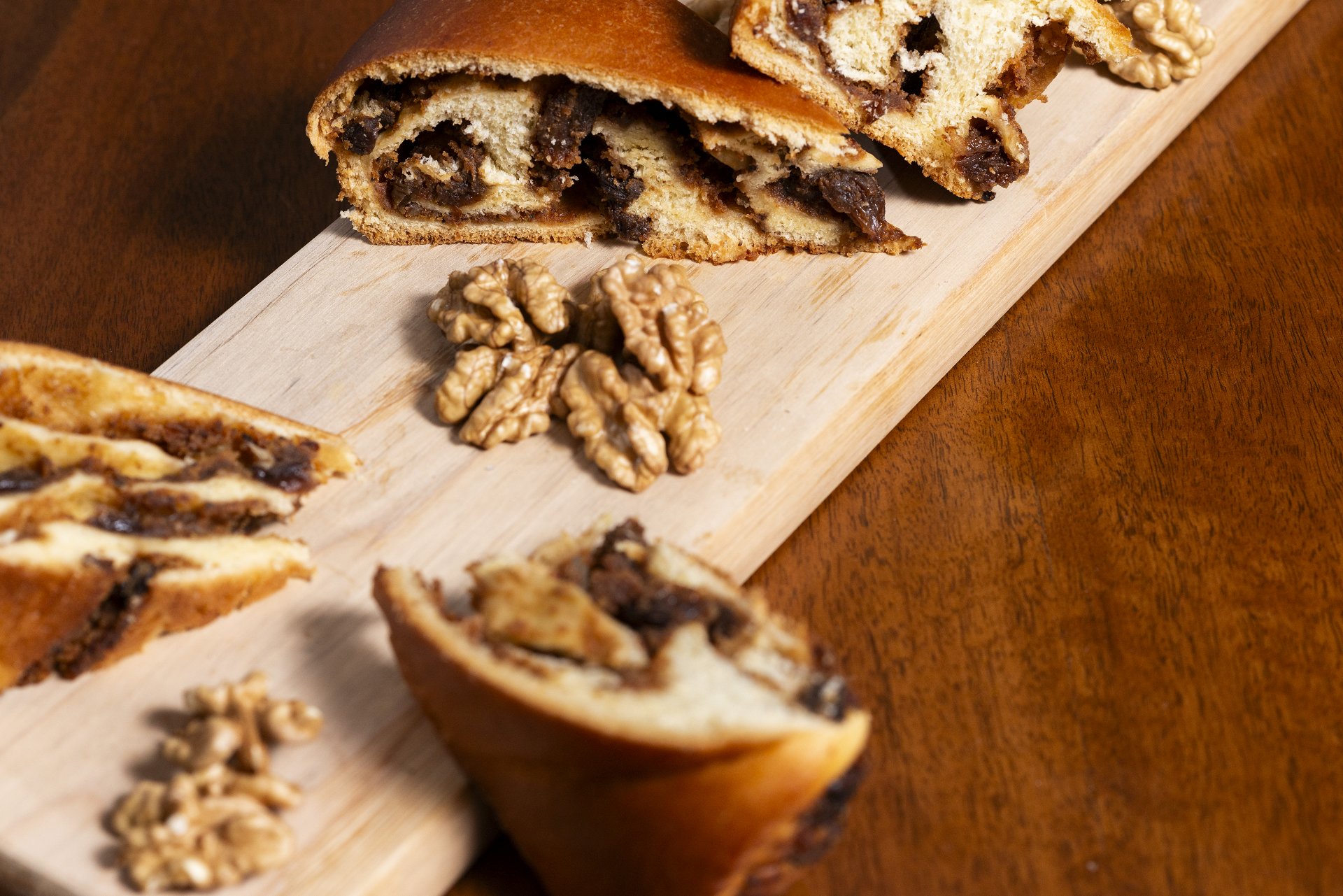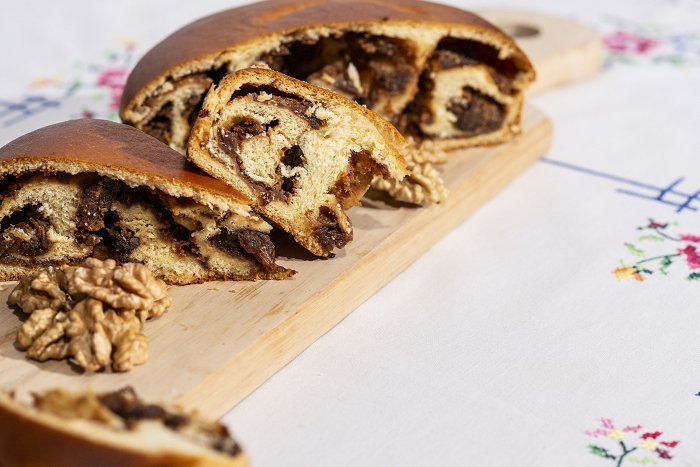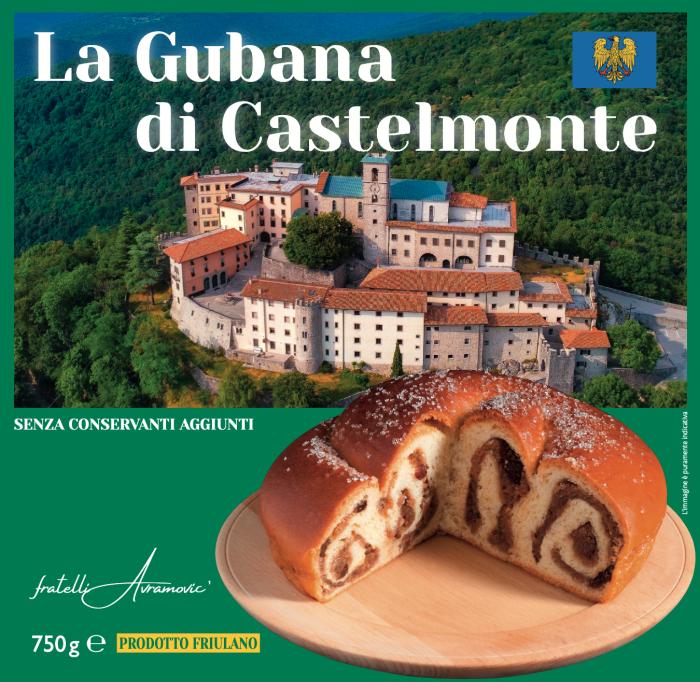If you say gubàna / gubànza / gubànca, you say Valli del Natisone, that part of Benečija this cake has cheered for centuries the happy events of families and communities, such as weddings, village festivals and important religious celebrations. There is no feast without the gubana, as it is unique in its intrinsic value, beautiful because of its shape, good because it encloses in its golden casing the sweetest thing this generous and rugged land produces. The recipe, which skilfully harmonises genuine and local ingredients, dates back to ancient times. It is said that the cake was part of the 72 dishes served at the banquet set up in honour of the Venetian Pope Gregory XII, at the General Council held on 26 May 1409 in Cividale del Friuli.
The origins of gubana still remain without a precise date. The oldest evidence dates back to the 16th century, when the surnames Gubana and Gubaniza were already widespread in the Natisone Valley. These were probably nicknames referring to people who were very good at making the cake or enjoyed it willingly, or resembled its rounded shape.
Gubana / Guban(i)ca, derives from the Slovenian guba meaning fold, and indicates the shape of the cake, which is obtained by wrapping the filling in the pastry, then twisting the long cylinder obtained in a spiral to obtain the characteristic snail shape.
Until the 1960s, the gubana was made exclusively at home by expert women who had inherited the recipe and secrets from their mothers or grandmothers. After shaping it, they would brush the top with beaten egg and sprinkle it with sugar, then bake it or take it to bake in houses with a suitable oven heated with tiny branches.
The occasion that started the production of this cake at artisanal level was the competition for the best gubana, held in 1965 in San Pietro al Natisone, for the feast of the patron saint. This event was decisive for its future and marked the beginning of its large-scale promotion by local companies. Over the years, their number increased and some of them even settled outside the gubana's home territory.
The leap from homemade to large-scale range, and the diffusion of the cake even beyond the regional borders has caused the authenticity of the recipe and the original significance that gubana has had over the centuries to be partly lost. In advertising and the media, it has become a Friulian speciality, or a cake original from Gorizia and Cividale, which also boast a cake similar in shape. But the difference between them lies in the dough: leavened for the Benecia gubana, and puff pastry for the Cividale and Gorizia gubana, the latter also called presnitz.
Any attempt to bring the production of gubana back into the territory where it originated with a mark certifying its origin and official recipe were in vain. The measure would have made the typical dessert of the Natisone Valleys more competitive, promoted the area and paid homage to the community that had conceived and produced it over the centuries.
The basic ingredients of the gubana filling are chopped walnuts, sultanas softened in schnapps, pine nuts and sugar, all flavoured preferably with a little slivovka, a plum schnapps. But every cook has their secrets, inherited from their mothers and grandmothers and jealously guarded, and adds or substitutes flavours and ingredients that make the cake part of family traditions.
The gubana enjoyed today in the Natisone Valleys is the product of a culinary art that evolved over the centuries from a cake that had chestnuts and a few other ingredients as its filling, including honey - before sugar became so common - and raisins. In some families it is still made with chestnuts, but it has become a rare excellence.
How much the gubana was considered the symbol of the feast is testified by the fact that it was elevated to the status of wedding queen. The bride offered it to the priest wrapped in a white napkin and, at the end of the wedding banquet, it was given to every guest as a wedding favour. We can only imagine the work and time put into making such a quantity of cake, but no family shirked this custom, to the extent that gubana had become synonymous with marriage. In order to discover the new, not yet official, engaged couples in Drenchia, they were addressed like this: "Ka' bomo pekli gubance? / What, are we going to cook gubane?".
But just as there were no weddings without gubane, there were no village festivals without them either, which drew people from all over and provided an opportunity to invite distant relatives, to close deals and, for young people, to get to know each other, sympathise and fall in love. Particularly popular was the feast for the patron saint of San Pietro al Natisone, which Ivan Trinko, in his Guide to the Julian Pre-Alps (1912), describes as follows: "St. Peter's 'festival', which falls on the 29th of June, is known as one of the most attractive, and in fact it attracts a huge crowd of foreigners from all over, eager to enjoy the exquisite gubana (gubànza), a speciality of these towns, and to wash it down with the so-called 'cividino' wine, another equally tasty speciality" (p. 626). And further on, regarding the great feast that was held on San Martino in September, which drew people from both sides of the border, he recalls that, after the celebration of mass, accompanied by 'traditional, grave and truly sacred songs', people poured out onto the meadows adjacent to the church, dividing into groups, and continues: "Filled jugs [of wine] regularly go round and round in circles from mouth to mouth, while the solid part of the 'comfort' is represented by gubànza, a delicious speciality of these Slovenian towns' (p. 677).
From what has been said, we can understand that for the people of the Natisone Valleys, gubana had an identity value, it was an indispensable ritual in the calendar cycle and a reason for joyful feelings and poignant emotions in a context of deprivation and dissolved dreams... Dino Menichini, a writer and journalist born in Stupizza, experienced all this and has admirably expressed it in these verses:
A slice of gubana
Meant Christmas, Epiphany,
The day of patron saint St Florian,
Confirmations, weddings to us ...,
But in the heart
It did not compensate for all the meagre bread
Chewed in silence for many seasons.
Mothers expertly
Mixed nuts,
Crushed pine nuts and sultanas
Long in the mortar,
They added breadcrumbs to it,
Homemade liqueur:
And then arranged the sweet amalgam
In the strip of dough
To make a spiral
Beaded with sugar
With a sign of the cross.
Gubana
That brought its fragrance
Throughout the town
Was the feast of an already wasted day
From our long wait,
By the thought that meagre bread
We would still chew on
For seasons to come.



